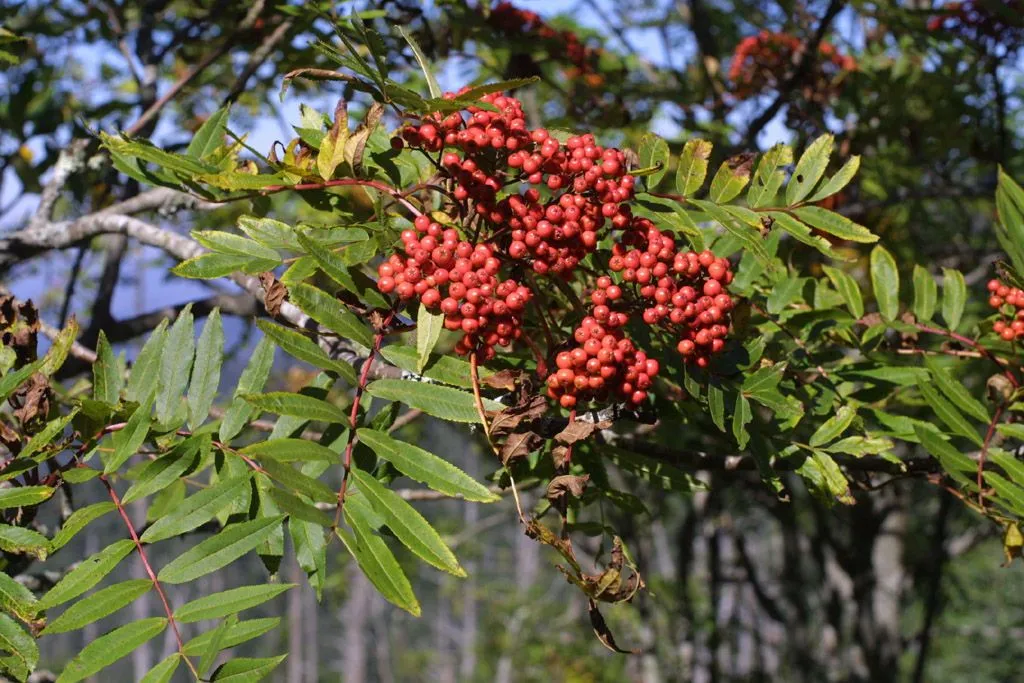
Author: Marshall
Bibliography: Arbust. Amer.: 145 (1785)
Year: 1785
Status: accepted
Rank: species
Genus: Sorbus
Vegetable: False
Observations: E. Canada to NC. & E. U.S.A.
The Mountain-ash, scientifically known as Sorbus americana, is an elegant deciduous tree native to the forests of eastern North America, ranging from eastern Canada down to North Carolina and into parts of eastern the United States. This tree, a proud member of the Rosaceae family, was first described by Marshall in 1785, highlighting its longstanding recognition in botanical literature.
Revered for both its ecological importance and ornamental value, the Mountain-ash boasts compound leaves made up of several slender leaflets. These leaves turn a brilliant red or orange in the autumn, providing a spectacular display of color. During the spring, the tree is adorned with clusters of small, creamy-white flowers. These blooms not only add to the tree’s visual appeal but also serve as an essential source of nectar for various pollinators.
Following its flowering period, the Mountain-ash produces bright red or orange berries, known as pomes, which persist into the winter months. These vividly colored berries are not just visually striking; they also provide a crucial food source for birds and other wildlife during the colder seasons.
Ecologically, the Mountain-ash plays a significant role in forest biodiversity. Its berries attract a myriad of bird species, while its flowers support a plethora of insects, thus contributing to a vibrant and balanced ecosystem. It thrives in a variety of soil types but prefers well-drained soils and can often be found in mixed hardwood forests and along the margins of swamps and streams, showcasing its adaptability.
Cultivated for its aesthetic appeal, the Mountain-ash is a common choice for parks and gardens, where it can be appreciated both for its striking seasonal changes and its wildlife-friendly properties. Gardeners and landscapers value it for its relatively low-maintenance nature and its ability to bring life and color to the landscape.
In summary, Sorbus americana, or Mountain-ash, is a cherished species both in the wild and in cultivated landscapes. Its vibrant foliage, flower clusters, and colorful berries, along with its ecological benefits, ensure that this tree holds a special place in the hearts of botanists, gardeners, and nature enthusiasts alike.
Eng: american mountain-ash, mountain-ash, american mountain ash, dogberry, roundwood
Swe: amerikansk rönn
Fra: sorbier d’amérique, cormier, maska, maskouabina
En: Mountain-ash, American mountain-ash, American mountain ash, Dogberry, Roundwood
Fr: Sorbier d’Amérique, Cormier, Maska, Maskouabina
Sv: Amerikansk rönn
Taken Sep 9, 2021 by nathalie prefontaine (cc-by-sa)
Taken Jun 3, 2020 by Poirier Martin (cc-by-sa)
Taken Jul 22, 2022 by Richard Jensen (cc-by-sa)
Taken Sep 11, 2021 by Greg Wolford (cc-by-sa)
Taken May 28, 2022 by Lavigne Mathieu (cc-by-sa)
Taken Oct 2, 2021 by Caryssa Rouser (cc-by-sa)
Taken Aug 29, 2021 by Eric Eric Davies (cc-by-sa)
Taken Aug 15, 2020 by Mary-Dan Johnston (cc-by-sa)
Taken Sep 2, 2021 by Jamie A (cc-by-sa)
Taken Sep 12, 2019 by Jessica jessicaflag (cc-by-sa)
Taken Jun 18, 2006 by EOL − Steven J. Baskauf (cc-by-nc-sa)
Taken Jun 18, 2006 by EOL − Steven J. Baskauf (cc-by-nc-sa)
Taken Jun 8, 2021 by Barb T (cc-by-sa)
Taken May 9, 2022 by Chen Mary (cc-by-sa)
Taken Aug 23, 2022 by Jordi Gómez (cc-by-sa)
Taken Sep 7, 2002 by EOL − Steven J. Baskauf (cc-by-nc-sa)
Taken Jan 1, 1900 by EOL − Gerrit Davidse (cc-by-nc-sa)
Taken Sep 2, 2021 by Jamie A (cc-by-sa)
Taken Aug 15, 2020 by Mary-Dan Johnston (cc-by-sa)
Taken Aug 15, 2020 by Mary-Dan Johnston (cc-by-sa)
Taken Sep 7, 2002 by EOL − Steven J. Baskauf (cc-by-nc-sa)
Taken Sep 7, 2002 by EOL − Steven J. Baskauf (cc-by-nc-sa)
Taken Sep 7, 2002 by EOL − Steven J. Baskauf (cc-by-nc-sa)
Taken Jun 18, 2006 by EOL − Steven J. Baskauf (cc-by-nc-sa)
Taken Jun 18, 2006 by EOL − Steven J. Baskauf (cc-by-nc-sa)
© copyright of the Board of Trustees of the Royal Botanic Gardens, Kew.
© copyright of the Board of Trustees of the Royal Botanic Gardens, Kew.
© copyright of the Board of Trustees of the Royal Botanic Gardens, Kew.
Growth form>: Single Stem
Growth habit>: Tree, Shrub
Growth rate>: Moderate
Ph maximum: 6.8
Ph minimum: 5.3
Family: Myrtaceae Author: (F.Muell.) K.D.Hill & L.A.S.Johnson Bibliography: Telopea 6: 402 (1995) Year: 1995 Status:…
Family: Rubiaceae Author: Pierre ex A.Froehner Bibliography: Notizbl. Bot. Gart. Berlin-Dahlem 1: 237 (1897) Year:…
Family: Sapindaceae Author: Koidz. Bibliography: J. Coll. Sci. Imp. Univ. Tokyo 32(1): 38 (1911) Year:…
Family: Asteraceae Author: A.Gray Bibliography: Pacif. Railr. Rep.: 107 (1857) Year: 1857 Status: accepted Rank:…
Family: Fabaceae Author: Medik. Bibliography: Vorles. Churpfälz. Phys.-Ökon. Ges. 2: 398 (1787) Year: 1787 Status:…
Family: Aspleniaceae Author: (Cav.) Alston Bibliography: Bull. Misc. Inform. Kew 1932: 309 (1932) Year: 1932…